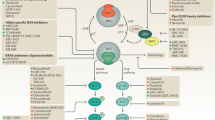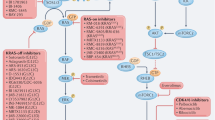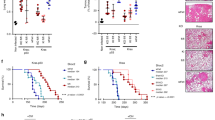Abstract
RAS mutations are the most common gain-of-function change in human cancer and promise to be a critical therapy target. As a new approach, we have used a surrogate to drug the ‘undruggable’ (that is, RAS-effector protein–protein interactions inside cancer cells) in pre-clinical mouse models of RAS-dependent cancers. Using this novel reagent, we have specifically targeted RAS signalling in a transgenic mouse model of lung cancer by directly blockading RAS-effector interactions with an antibody fragment that binds to activated RAS, and show that the interaction of RAS and effectors, such as phosphoinositide 3-kinase and RAF, is necessary for tumour initiation. Further, interference with oncogenic RAS–effector interactions result in control of tumour growth in human cancer cells but, crucially, does not necessarily cause tumour regression. These findings support the concept that ablating RAS-dependent signalling in cancer will have chemo-preventive effects that confer a chronic state in cancer and suggest that mutant RAS-targeted therapies may require conjoint targeting of other molecules and/or current cancer therapeutic strategies (for example, radiotherapy and chemotherapy) to be curative. In this context, our findings suggest that the oncogene addiction model is not universally correct in its central thesis that cancer cell death is inevitable after loss of oncogenic protein function.
This is a preview of subscription content, access via your institution
Access options
Subscribe to this journal
Receive 50 print issues and online access
$259.00 per year
only $5.18 per issue
Buy this article
- Purchase on Springer Link
- Instant access to full article PDF
Prices may be subject to local taxes which are calculated during checkout




Similar content being viewed by others
References
Brummelkamp TR, Bernards R, Agami R . (2002). Stable suppression of tumorigenicity by virus-mediated RNA interference. Cancer Cell 2: 243–247.
Chin L, Tam A, Pomerantz J, Wong M, Holash J, Bardeesy N et al. (1999). Essential role for oncogenic Ras in tumour maintenance. Nature 400: 468–472.
Dankort D, Filenova E, Collado M, Serrano M, Jones K, McMahon M . (2007). A new mouse model to explore the initiation, progression, and therapy of BRAFV600E-induced lung tumors. Genes Dev 21: 379–384.
Downward J . (2003). Targeting RAS signalling pathways in cancer therapy. Nat Rev Cancer 3: 11–22.
Drosten M, Dhawahir A, Sum EY, Urosevic J, Lechuga CG, Esteban LM et al. (2010). Genetic analysis of Ras signalling pathways in cell proliferation, migration and survival. EMBO J 29: 1091–1104.
Fisher GH, Wellen SL, Klimstra D, Lenczowski JM, Tichelaar JW, Lizak MJ et al. (2001). Induction and apoptotic regression of lung adenocarcinomas by regulation of a K-Ras transgene in the presence and absence of tumor suppressor genes. Genes Dev 15: 3249–3262.
Forbes S, Clements J, Dawson E, Bamford S, Webb T, Dogan A et al. (2006). Cosmic 2005. Br J Cancer 94: 318–322.
Gatenby RA . (2009). A change of strategy in the war on cancer. Nature 459: 508–509.
Gupta S, Ramjaun AR, Haiko P, Wang Y, Warne PH, Nicke B et al. (2007). Binding of ras to phosphoinositide 3-kinase p110alpha is required for ras-driven tumorigenesis in mice. Cell 129: 957–968.
Herrmann C . (2003). Ras-effector interactions: after one decade. Curr Opin Struct Biol 13: 122–129.
Ikediobi ON, Davies H, Bignell G, Edkins S, Stevens C, O'Meara S et al. (2006). Mutation analysis of 24 known cancer genes in the NCI-60 cell line set. Mol Cancer Ther 5: 2606–2612.
Johnson L, Mercer K, Greenbaum D, Bronson RT, Crowley D, Tuveson DA et al. (2001). Somatic activation of the K-ras oncogene causes early onset lung cancer in mice. Nature 410: 1111–1116.
Karnoub AE, Weinberg RA . (2008). Ras oncogenes: split personalities. Nat Rev Mol Cell Biol 9: 517–531.
Kim CF, Jackson EL, Woolfenden AE, Lawrence S, Babar I, Vogel S et al. (2005). Identification of bronchioalveolar stem cells in normal lung and lung cancer. Cell 121: 823–835.
Meuwissen R, Linn SC, van der Valk M, Mooi WJ, Berns A . (2001). Mouse model for lung tumorigenesis through Cre/lox controlled sporadic activation of the K-Ras oncogene. Oncogene 20: 6551–6558.
Nassar N, Horn G, Herrmann C, Scherer A, McCormick F, Wittinghofer A . (1995). The 2.2 A crystal structure of the Ras-binding domain of the serine/threonine kinase c-Raf1 in complex with Rap1A and a GTP analogue. Nature 375: 554–560.
Okada F, Rak JW, Croix BS, Lieubeau B, Kaya M, Roncari L et al. (1998). Impact of oncogenes in tumor angiogenesis: mutant K-ras up-regulation of vascular endothelial growth factor/vascular permeability factor is necessary, but not sufficient for tumorigenicity of human colorectal carcinoma cells. Proc Natl Acad Sci USA 95: 3609–3614.
Pacold ME, Suire S, Perisic O, Lara-Gonzalez S, Davis CT, Walker EH et al. (2000). Crystal structure and functional analysis of Ras binding to its effector phosphoinositide 3-kinase gamma. Cell 103: 931–943.
Plattner R, Anderson MJ, Sato KY, Fasching CL, Der CJ, Stanbridge EJ . (1996). Loss of oncogenic ras expression does not correlate with loss of tumorigenicity in human cells. Proc Natl Acad Sci USA 93: 6665–6670.
Sharma SV, Settleman J . (2007). Oncogene addiction: setting the stage for molecularly targeted cancer therapy. Genes Dev 21: 3214–3231.
Shirasawa S, Furuse M, Yokoyama N, Sasazuki T . (1993). Altered growth of human colon cancer cell lines disrupted at activated Ki-ras. Science 260: 85–88.
Soriano P . (1999). Generalized lacZ expression with the ROSA26 Cre reporter strain. Nat Genet 21: 70–71.
Tanaka T, Williams RL, Rabbitts TH . (2007). Tumour prevention by a single antibody domain inhibiting binding of signal transduction molecules to activated RAS. EMBO J 26: 3250–3259.
Vetter IR, Wittinghofer A . (2001). The guanine nucleotide-binding switch in three dimensions. Science 294: 1299–1304.
Weinstein IB . (2002). Cancer. Addiction to oncogenes--the Achilles heal of cancer. Science 297: 63–64.
Weinstein IB, Joe A . (2008). Oncogene addiction. Cancer Res 68: 3077–3080.
Weir B, Zhao X, Meyerson M . (2004). Somatic alterations in the human cancer genome. Cancer Cell 6: 433–438.
Acknowledgements
This work was funded by grants from the Medical Research Council and the University of Leeds. We wish to thank Dr. Anton Berns for the conditional, Cre-dependent K-RasV12 transgenic mouse line. We also thank Dr Jeffrey A Whitsett for pCC10CAT-2300 for constructing the CC10 transgenic cassette. We are indebted to Debra Evans, Deborah Carter, Gillian Cardwell for animal husbandry, to Lesley Drynan for expert assistance and to Mike Shires for histology.
Author information
Authors and Affiliations
Corresponding author
Ethics declarations
Competing interests
The authors declare no conflict of interest.
Additional information
Supplementary Information accompanies the paper on the Oncogene website
Rights and permissions
About this article
Cite this article
Tanaka, T., Rabbitts, T. Interfering with RAS–effector protein interactions prevent RAS-dependent tumour initiation and causes stop–start control of cancer growth. Oncogene 29, 6064–6070 (2010). https://doi.org/10.1038/onc.2010.346
Received:
Revised:
Accepted:
Published:
Issue Date:
DOI: https://doi.org/10.1038/onc.2010.346
Keywords
This article is cited by
-
Peptidomimetics designed to bind to RAS effector domain are promising cancer therapeutic compounds
Scientific Reports (2022)
-
Pan RAS-binding compounds selected from a chemical library by inhibiting interaction between RAS and a reduced affinity intracellular antibody
Scientific Reports (2021)
-
A potent KRAS macromolecule degrader specifically targeting tumours with mutant KRAS
Nature Communications (2020)
-
Cancer cell killing by target antigen engagement with engineered complementary intracellular antibody single domains fused to pro-caspase3
Scientific Reports (2019)
-
PRL3-zumab as an immunotherapy to inhibit tumors expressing PRL3 oncoprotein
Nature Communications (2019)



